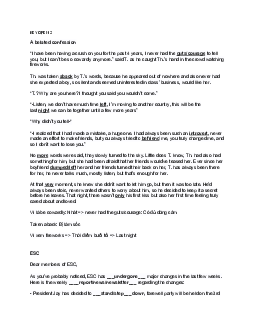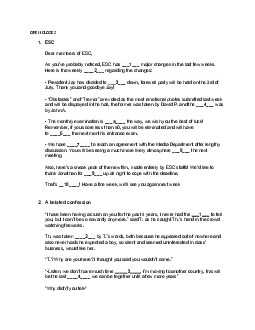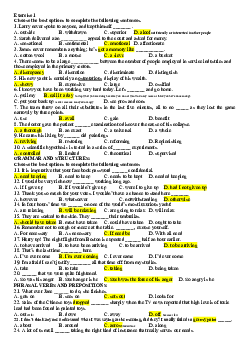







Preview text:
OPEN CLOZE TEST Passage 1
The Indian Ocean (1) __________ about 14% of the Earth’s surface area. This ocean region is enclosed on three sides by the landmasses
of Africa, Asia, and Australia. The Indian Ocean’s southern border is open to water exchange with the much colder Southern Ocean. Average
depth of the Indian Ocean is 3900 meters (12,800 feet). (2) __________ deepest point in this ocean region occurs in the Java Trench with
a depth of 7258 meters (23,812 feet) below sea level. The Indian Ocean region (3) __________ relatively few islands. Continental shelf
areas tend to be quite narrow and not many shal ow seas exist. Relative to the Atlantic Ocean, only a smal (4) __________ of streams
drain into the Indian Ocean. Consequently, the surface area of the Indian Ocean is approximately 400% larger (5) __________ the land area supply runoff into it. Passage 2
Everyone wants to reduce pol ution. But the pol ution problem is as complicated as it is serious. It is complicated (1) _____ much pol ution
is caused by things that benefit people. For (2) _____, exhaust from automobiles causes a large percentage of air pol ution, but the
automobile provides transportation (3) _____ mil ions of people. Factories discharge much of the material that pol utes the air and water,
but factories give employment to a large (4) _____ of people. However, pol ution can be gradual y reduced in several ways. Scientists can
work to find ways to lessen the amount of pol ution that such things as automobiles and factories cause. Governments can pass and enforce
laws that require businesses and traffic to stop, or to (5) _____ certain pol uting activities. Passage 3
Natural areas have a profound effect (1) _____ our physical and emotional health and wel being. In our increasingly frenetic world, our
national parks are important sanctuaries (2) _____ people can take time out, enjoy nature, get fit, relax and revitalise, whilst nature’s
inherent beauty serves as a source of artistic, creative and spiritual inspiration. Research on the benefits of contact with the natural
environment show that it is likely to have a significant positive psychological effect, serving to reduce stress, anger, frustration and
aggression, providing an opportunity for social bonding, (3) _____ serving as a place for learning and mental stimulation. Children in
particular display long-term benefits of playing outdoors. In addition to the obvious health and wel being benefits our national parks bring,
they also assist us in less obvious ways, (4) _____ as acting as natural buffers against extreme weather events, helping to control our
climate, providing us (5) _____ clean water, improving food security and serving as an important resource for the pharmaceutical industry. Passage 4
Another reason that music is so popular (1) __________ the variety of settings in which one can enjoy his or her favourite kind of music.
You can go to a church to hear great religious music, or to a concert hal to hear a wel -known classical symphony. (2) __________ another
night, you might go to a smal club to listen to an up-and-coming jazz group while you enjoy a drink. A few nights (3) __________, you
might go with some friends to join thousands of other people in a stadium to hear your favourite rock band play in your city on a world
tour. And, back at your house or apartment, you can relax while you put in a tape or CD and (4) __________ to your favourite artists again
and again in your (5) __________ home. Passage 5 HOW DO THEY MAKE CARTOONS?
Cartoons (1) __________ cal ed animated films. Artists draw the scenes. They draw the background and the characters. Each drawing of
the character is slightly different. (2) __________ example, the legs are (3) __________ different places if the character is running. A
special camera takes pictures of each scene the artist has drawn. When the pictures are played back, it looks like the character is running.
Making drawings that seem (4) __________ move is cal ed animation.
Some enjoyable animated films include Snow White and the Seven Dwarfs (1937), Beauty and the Beast (1991), The Lion King (1994), and
Finding Nemo (2003). In some films, there are (5) __________ animated characters and human actors, as in Space Jam (1996). Space
Jam stars Bugs Bunny and basketbal star Michael Jordan. Passage 6
I know a boy (1) __________ Michael who has a remarkable talent. He knows an incredible amount about footbal teams and footbal
leagues. He can recite the names of the players, tel you the result of every match played last weekend and who (2) __________ the goals,
and can give you the history of any footbal club you care to name. What I find the most extraordinary of al is that he is as knowledgeable
about Spanish and German footbal (3) __________ he is about English. He (4) __________ a great amount of time going through footbal
magazines and the sports pages of newspapers. He is quite an expert on footbal . However, he (5) __________ not play the game himself
and only goes very occasional y to a match. Passage 7
New York (1) __________ the world’s most ethnical y diverse city. About one-third of New York’s residents, over 2.6 mil ion people, were
born in other countries. Schoolkids in New York speak more than 120 languages.
The city is ful (2) __________ famous buildings that you may often see on television. They include the Empire State Building, United
Nations headquarters, Chrysler Building, and Rockefel er Centre. The Statue of Liberty stands in New York Harbour. It has welcomed mil ions
of immigrants (3) __________ America. Two of the world’s tal est buildings once soared above New York’s skyline. They were the twin
towers of the World Trade Centre. But terrorists flew airplanes into the towers and destroyed them (4) __________ September 11, 2001.
Central Park is an oasis of greenery in the midst of New York’s tal buildings. (5) __________ offers a zoo, a nature centre, playgrounds,
paths for running and bicycling, and places for ice skating, rol er skating, and playing sports. Passage 8
The Amazon River basin is a vast expanse, covering parts of eight countries in South America. It (1) __________ made up of varied types
of environments that are home to thousands of species of animals and plants.
The Amazon basin has not only rainforests, (2) __________ flooded forests as wel . Every year, the Amazon River and its tributaries overflow
their banks and flood nearly 116,000 square miles of forests. The region's streams and rivers contain 20 per cent of the earth's fresh water.
The freshwater ecosystems host an extraordinary seasonal migration of aquatic and terrestrial animals in and out of the flooded forests.
These flooded forests and freshwater ecosystems of the Amazon contain several species found nowhere else (3) __________ earth. Among
them are two fishes that are highly prized for human consumption: a fruit-eating fish cal ed the tambaqui, and the pirarucz, (4) __________
largest scaled freshwater fish in the (5) __________. Passage 9
The streets were flooded (1) __________ a sea of red and gold as flag-waving fans, many also wearing red headbands that said,
“Vietnam Wins”, fil ed parks and public squares to watch the final (2) __________ big screens. Mil ions of red-clad Vietnam fans saw their
hopes of a fairytale ending dashed Saturday as Uzbekistan snatched a last-minute victory in the final of the U23 Asian Cup championship.
(3) __________ the loss, the huge crowd of fans were bursting with national pride as they streamed home, some stil chanting “Vietnam the champion!”
After the match, footbal commentator Dang Gia Man praised the team (4) __________ their performance throughout the tournament
– and for bringing (5) __________ nation together like no other sporting event has in recent history. Passage 10
We are al slowly destroying the earth. The seas and rivers are (1) __________ dirty to swim in. There is so much smoke in the air that it
is unhealthy to live in many of the world’s cities. In one wel -known city, for example, poisonous gases from cars pol ute the air so much
(2) __________ traffic policemen have to wear oxygen masks.
We have cut down so many trees that there are now vast areas of wasteland al over the world. (3) __________ a result, farmers in parts
of Africa cannot grow enough to eat. In certain countries in Asia there (4) __________ too little rice. Moreover, we do not take enough
care (5) __________ the countryside. Wild animals are quickly disappearing. We must act now before it is too late to do anything about it.
Join us now. Save the Earth. This is too important to ignore. Passage 11
Many of us are stil unaware (1) __________ or are indifferent to the need to preserve rare species. Some people argue that species have
(2) __________ dying out since life began. "So why should we worry about them now ?" they ask. They calmly believe (3) __________
others would take their place. What these people (4) __________ not realize is that it wil take mil ions of years before a set of species is
evolved to replace those we are rapidly losing. These species are our national heritage. We should not let (5) __________ die off. They
should be preserved for our descendants. Passage 12
Sepakraga is one (1) __________ the traditional games of Malaysia. It uses an open bal (2) __________ of rattan strips, plaited together.
It can (3) __________ played by five or ten players. During the game, the players stand in a circle at equal distances from one another.
One of the players begins the game by kicking the bal to another team member. The aim of the game (4) __________ not to al ow the
bal to fal to the ground. Usual y, (5) __________ is a record keeper to keep count of the number of kicks made before this happens.
Sepakraga is popular in Negeri Sembilan. Passage 13
Emperor Penguins breed on land. In autumn, the eggs are laid. (1) __________ penguin lays one egg only. For (2) __________ next 64
days, the male guards it The penguin rests the egg on (3) __________ feet, covering it with the fold of skin on its bel y. This is to protect
the eggs from being snatched (4) __________ sea birds. Meanwhile, the females disperse in search of food. When the incubation period is
over, they return to take (5) __________ of the young. The parents rear it al through the winter. Passage 14
Al animals have some means of protecting themselves, (1) __________ these means vary according to the animal's species nature and
habitat. The chameleon blends into its background by subtle changes of colour. The skunk, (2) __________ the other hand, repels it
enemies with a fine spray of evil-smel ing fluid in their direction. A few species of (3) __________ like the electric eel and electric catfish
have an extraordinary means of defence. These fish use electric shocks as a defence weapon (4) __________ enemies and to stun their
prey as wel . The most famous of al (5) __________ the electric eel of the rivers of South America. It can generate from 370 to 550 volts,
kil ing the fish and frogs on which it feeds. Passage 15
Sharks live in oceans and seas al over the world, and even (1) __________ some rivers and lakes, especial y in warmer waters. Some
sharks live near the surface, some live deep in the water, and (2) __________ live on or near the ocean floor. Pelagic sharks ( sharks living
in the open ocean ) include the Great White Shark and the Basking Shark. Benthic Sharks, or those living at the bottom, include the Zebra
Horn Shark and the Angel shark, (3) __________ usual y have flattened camouflaged bodies that let them hide in the seabed. Some sharks
even venture many miles up into the fresh water of rivers like the Mississippi in the United States (4) __________ the Amazon in Brazil.
Unfortunately, the largest sharks are (5) __________ in numbers around the world because they are being hunted by people. The numbers
of Great White Shark, the Basking Shark and the Whale Shark are al waning.
------------------------------------------------------------------------------------------------------------------------------------------------------------------------
------------------------------------------------------------------------------------------------------------------------------------------------------------------------
------------------------------------------------------------------------------------------------------------------------------------------------------------------------
------------------------------------------------------------------------------------------------------------------------------------------------------------------------
------------------------------------------------------------------------------------------------------------------------------------------------------------------------
------------------------------------------------------------------------------------------------------------------------------------------------------------------------
------------------------------------------------------------------------------------------------------------------------------------------------------------------------
------------------------------------------------------------------------------------------------------------------------------------------------------------------------
------------------------------------------------------------------------------------------------------------------------------------------------------------------------
------------------------------------------------------------------------------------------------------------------------------------------------------------------------
------------------------------------------------------------------------------------------------------------------------------------------------------------------------
------------------------------------------------------------------------------------------------------------------------------------------------------------------------
------------------------------------------------------------------------------------------------------------------------------------------------------------------------
------------------------------------------------------------------------------------------------------------------------------------------------------------------------
------------------------------------------------------------------------------------------------------------------------------------------------------------------------
------------------------------------------------------------------------------------------------------------------------------------------------------------------------
------------------------------------------------------------------------------------------------------------------------------------------------------------------------
------------------------------------------------------------------------------------------------------------------------------------------------------------------------
------------------------------------------------------------------------------------------------------------------------------------------------------------------------
------------------------------------------------------------------------------------------------------------------------------------------------------------------------ PASSAGE 1
Most people are afraid of sharks, but they usual y do not know much about them. For example, there are about 350
species of sharks that live in oceans over the world. Al of the sharks are carnivores, but most of them don't attack people.
Some sharks are very smal - the smallest shark is about 6 inches long - about as long as your hand. But some sharks are
very large. The largest species of sharks may be 60 feet long and weigh 15 tons. Unlike many other kinds of fish, sharks do
not have bone. Their bodies are made up of a kind of tough white flexible material (cal ed cartilage). Sharks do not have ears.
However, they 'hear' sounds and movements in the wade. Any sound or movement makes the water vibrates. Sharks can feel
these vibrations and they help the sharks find food. Sharks use their large eyes to find food, too. Most sharks see best in low
light. They often hunt for food at dawn. in the evening, or in the middle of the night.
Nowadays scientists want to learn more about sharks for several reasons. For example, cancer is common in many
animals, including, people. However. it is rare in sharks. Scientists want to find out why sharks almost never get cancer. Maybe
this information can help people prevent cancer too.
Question 1: According to the passage, sharks __________. A. are big mammals B. usually live in warm water C. are meat eaters D. always attack humans
Question 2: How long is a smal est shark?
A. About 6 centimetres B. As long as a hand C. As one's long hand D. About 1,5 meters
Question 3: The word 'they' in line 7 refers to __________. A. sharks B. sounds C. vibrations D. movements
Question 4: Sharks can hunt for food at night because __________.
A. they 'hear' more clearly at night. B. their eyes are large.
C. they feel vibrations in the water. D. they see wel in the dark.
Question 5: Which of the fol owing is NOT true?
A. Large sharks can weigh up to 15,000 kg.
B. Sharks' bodies are made up of cartilage.
C. Sharks can find their food by feeling vibrations.
D. Sharks often attack people.
Question 6: It can be inferred from the last paragraph that __________. A. sharks are being studied.
B. the cancer risk among animals is found to be higher.
C. scientists are given permission to catch sharks for their studies.
D. information about sharks help people cure cancer. PASSAGE 2
Dolphins live with the whales in the oceans. But dolphins come much closer to the shore. They wil come as close to
the shore as you or I can walk without going under water. Dolphins have teeth. Look at a dolphin you would not think it has a
nose, but surprisingly, it does! They have nostrils called blowholes. Over mil ions of years of evolution, whales’ dophins’
nostrils moved to the top of their head. This allows them to breathe by surfacing instead of them sticking their whole head out
of water. The first thing a new-born dolphin must do is to go to the surface to breathe. But the baby cannot swim so its mother
and another dolphin wil help push the baby to the surface for its first breath of air. The baby will be able to swim in about 30 minutes.
Dolphin navigate by following the hills and mountains of the ocean floor, by tracking the sun, by sensing currents, and
by tasting the water along the journey. A dolphin’s sound probably originated in its nasal passages. These nasal passages
are located on the top of the head. Dolphins can make sounds to see what lies ahead. This sense is cal ed echolocations.
The dolphins’ sound waves hit an object and the echo bounces back.
Question 1: The passage is mainly about __________.
A. Dolphin’s biological characteristics B. Dolphin’s stalking prey C. Dolphin’s childbearing D. Dolphin and whales
Question 2: Dolphins use the fol owing to navigate EXCEPT __________. A. sensing currents B. tracking the sun C. hearing the sounds D. tasting the water
Question 3: The word “evolution” in paragraph 1 is closest in meaning to __________. A. existence B. development C. appearance D. survival
Question 4: According to the passage, which of the fol owing is NOT true?
A. Dolphins have blowholes on the top of their head.
B. Baby dolphins must go to the surface as soon as they are born for their first breath.
C. Following the seabed’s mountains can help dolphins navigate.
D. Dolphins can make sounds thanks to their mouth.
Question 5: Which of the fol owing can best describe the feature of this passage? A. entertaining B. information C. novelistic D. sarcastic



